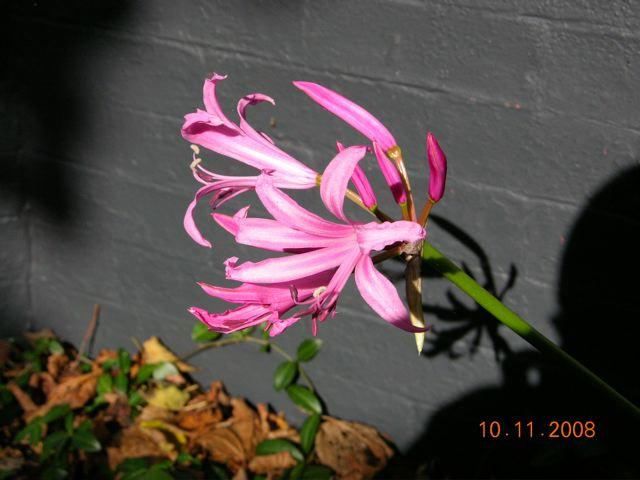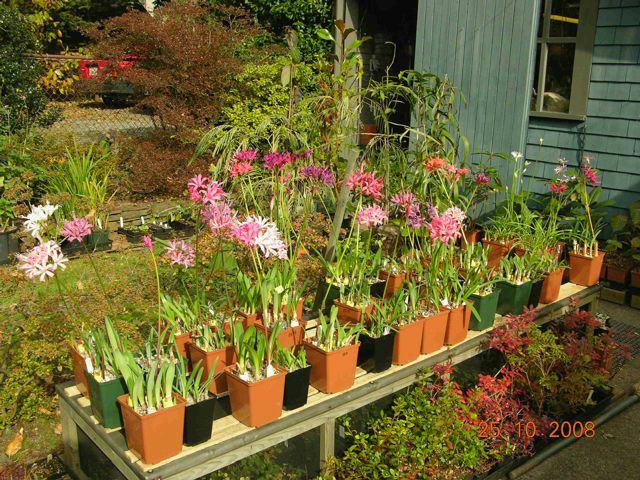We just had our first hard frost this week in Halifax, then Friday night we got clipped by a nor'easter that dumped 30-cm of snow. Hopefully it will be gone in a week but you never know. It certainly put an end to the Nerine bowdenii in bloom against the house as the temperature fell to -4c before the snow started. This bowdenii is the sole survivor of a dozen bulbs I planted maybe 20 years ago. It only started bloom a few years when the city limbed up an old linden street-side.

This may be Pink Triumph but I'm not certain.
A kind fellow in Sweden is sending me seed of var. wellsii which is said to be much hardier, he grows it in the open garden away from the warmth of the house foundation. I'm wondering if you have found var. wellsii significantly hardier than the bowdenii of the trade or, any other Nerine species for that matter? N. krigei is said to be hardy but I know of no one who has it let alone growing outside.
In 1996 I got seed of about 20 hand-pollinated crosses from Sir Peter, some interesting colours have come from the seed. Presently I have about 30 pots of bulbs from those crosses. I dearly wanted to decipher some of the parents listed only by code number in their complex parentages. I emailed Dr. Paul Chapman in the UK and he kindly sent me Sir Peter's spreadsheets listing all the Nerine crosses he had done as well as another file cross-referencing the crosses with his final selections. When I opened the excel file I was shocked me to see that Sir Peter had recorded the male parent first. Now I have to decide if I have to reverse all the crosses in my files, an onerous task requiring great care as these are very complex crosses! I wrote to Nicholas de Rothschild at Exbury Gardens, the repository of Sir Peter's many hybrids. Nicholas thought the whole exercise useless and he may very well be right. It occurred to me we would probably trace everything back to old Nerine cultivars and the original Exbury plants that Sir Peter used, sadly to my knowledge we do not know the parentages of these old hybrids either. So back to square one. One wonders just how many species are involved in
these crosses anyway - just sarniensis? - and if so where did the colour range come from? Is there such variation in the wild? Any thoughts?
Attached is a shot of some of the seedling pots as I was cleaning the greenhouse for winter several weeks ago. If I were to plant each bulb separately I would need an acre under glass.

John Weagle's Nerine Seedlings Blooming
I am just back from eastern Newfoundland where they have had Crocosmia aurea in their gardens for years. C. paniculata survived for 10 years here in Halifax against a greenhouse wall but recently disappeared when the ground froze deeply. Only Lucifer survives in Halifax, mainly in others' gardens as I cannot winter it at all. Friends here say it can skip a year after a hard winter and then mysteriously grow back and flower the same year. In extreme southern NS it is very vigorous. I wonder which ones might be hardy for you, realizing, of course, that your soil does not freeze as deeply
as it can here on occasion.
I have just given my Crocosmias to a friend in the south of NS and they have now been planted out in 9 long trenches. It will be interesting to see how they fare.
One last question. I have had several large pots of Lycoris radiata since 1976 and have never seen a flower. Perhaps we simply do not have enough summer heat to set buds. Do you think there are any of the Chinese species hardy outside or reliable bloomers?
Best regards,
John Weagle
Halifax, NS
Canada